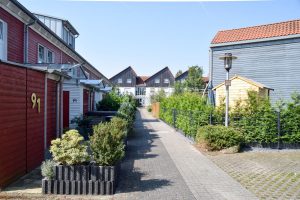73728 Esslingen Neue Weststadt: on 12 ha creates a CO2-neutral "showcase quarter" with 550 flats, around 260 office and commercial space units as well as a new building for the Esslingen University of Applied Sciences. The total investment volume is around 190 million euros. 30 percent of the quarter's use is planned for commercial purposes. Completion: 2023
Urban planning
The plans are based on an urban planning competition held in 2011.
CO2-neutral energy concept: energy storage and sector coupling
In the so-called "real laboratory", which is funded by the BMBF and BMWi, a neighbourhood energy supply concept is being realised with the sector coupling of electricity, heating, cooling and mobility.
For this purpose, an electrolyser with a capacity of 1 MWel absorbs surplus electricity generated by the PV systems (approx. 6 x 250 kWp => approx. 1,300 KWp) and the CHPs of the neighbourhood, which is not directly required for supply. This energy is used to support the splitting of water into hydrogen and oxygen in the electrolyser. The hydrogen produced is fed into a filling station and is thus available to filling stations and local businesses. In this way, the new quarter also supports the energy turnaround in urban mobility. The waste heat generated during electrolysis is also used directly in the quarter via a local heating network. If required, a small proportion of the hydrogen can be converted back into electricity in the district's CHP units or fuel cells and thus used to supply households with energy. In this way, the electrolyser also serves as an electricity storage system in accordance with the power-to-gas-to-power (P2G) approach. In addition, the use of waste heat from the electrolysis process via a local heating network is being tested. Cooling is generated by means of an adsorption refrigeration system in the area of the commercially used Block E.
Mobility
The area of mobility is of great importance for sustainable urban development. Interfaces between the stationary energy infrastructure and mobility in the neighbourhood should be used, for example, by offering public and semi-public charging stations. With the networking of charging and booking technology of the vehicles, a grid-serving operation is realised.
Calculations assume that 400 kilograms of hydrogen can be produced daily. This corresponds to an amount that would allow 400 hydrogen-powered cars to drive 100 kilometres.
Furthermore, the renewable surplus electricity of the "New West City" is to be fed directly and almost loss-free into the DC overhead line network of the electric buses, and a temporary, bidirectional use of the traction batteries in the buses for power grid stabilization is to be investigated.
Economics
Tenant electricity, smart networking and energy-conscious behavior are expected to save 20 to 25 percent of tenants' electricity costs.
First residential and commercial block
Bèla is the first of six residential/commercial blocks in the new Weststadt Esslingen. Construction began in 2016 and occupancy was in 2018. The three buildings have 132 residential units. The roof occupancy with a photovoltaic system of approx. 250 kWp enables the use of renewable energies, which are marketed via a tenant electricity model." Design: Architects Graf + Partner, Montabaur
- Commercial high-rise "Crystal Rock" in planning (as of 7/2020)
12 floors - Residential/commercial block "Bela", occupancy 2018
132 flats, 1,700 m² commercial space, 81 underground parking spaces. - Residential/commercial block "Citadis", occupation 2020
128 flats, 1,105 m² commercial, 22 parking spaces. - Residential/commercial block "Desiro", under construction. Completion: 2021
167 WE, 2.482 m² commercial, 91 TG-Stpl - Esslingen University
Stakeholders
The joint project "ES-West-P2G2P - Climate Neutral City Quarter Neue Weststadt Esslingen" is one of six lighthouse projects of the funding initiative Solar Construction/Energy Efficient City of the Federal Ministry for Economic Affairs and Energy (BMWi) and the Federal Ministry of Education and Research (BMBF), which was launched in 2016. The project consortium consists of 10 partners. The overall coordination and scientific management is carried out by the Steinbeis Innovation Center for Energy, Building and Solar Technology (SIZ-EGS), Stuttgart.
Awards / Sustainability labels
2011 the golden pre-certificate of the German Sustainable Building Council (DGNB)
www.dgnb.de/...neue-weststadt-esslingen
Video (1:06 h; 2020) Presentation of the Lok.West Quarter
Show the whole blog post >>
Video (12 min.; 2020) Presentation Norbert Fisch about the use of green hydrogen in the construction area "Neue Weststadt Esslingen
Show the whole blog post >>
Links
Project website
https://neue-weststadt.de
www.lokwest.de
Project website of the city of Esslingen
www.esslingen.de/…Lok%20West
BMBF/BMWi-Infos
www.energiewendebauen.de/...co2-neutrales-quartier...
Technical article dated 10/22/2020 in Building Energy Advisor:
www.geb-info.de/...klimaquartier-mit-power-gas-als-schluesseltechnologie
Last Updated: 26 September 2023
Similar projects on sdg21:
All project/s of the planning office: ; City region: Stuttgart and surrounding area; Country: Germany; Characteristics: 05 - 6 floors, Block Edge, Multi-storey housing; typology: Quartier; Thematic: 100% EEs, Car free living, CHP, DGNB, E-cars, Electromobility, Photovoltaics, Model settlement, Mix of uses, Plusenergiesiedlung, Hydrogen storage





